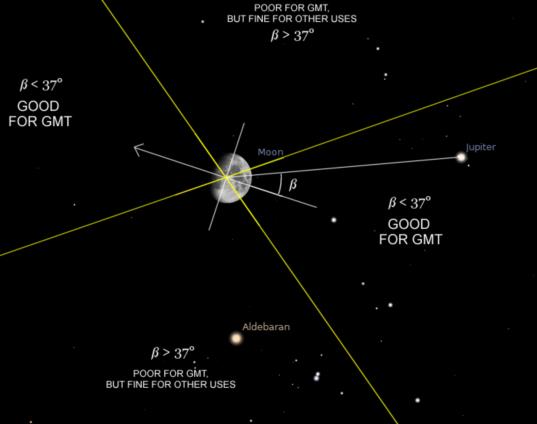
NavList:
A Community Devoted to the Preservation and Practice of Celestial Navigation and Other Methods of Traditional Wayfinding
From: Frank Reed
Date: 2013 Jan 27, 12:12 -0800
Hello Rodger, and welcome aboard!
You wrote:
"The measurement sensitivity is not too great to begin with."
It can be, if you're careful. With a good metal sextant, properly adjusted and equipped with a 7x or better scope, you can expect to determine longitude by lunars (from land or on a reasonably calm day at sea) within +/-3 miles two-thirds of the time by averaging four observations.
And you wrote:
"One must choose a comparing object that is as close to the lunar orbital plane as possible to get the maximum sensitivity (~ 0.5 arc min per minute of time). Best to stick with planets or the Sun."
Historically, the Sun was, by far, the preferred body. Celestial navigation was primarily a daylight activity back then. After that, the traditional lunars stars were used. The planets were added to most of the almanacs starting in the 1830s but this was too late for most lunarians. In dozens of 19th century logbooks and navigation notebooks, I have only seen one lunar recorded where the other body was a planet.
And you wrote:
"If the comparing object has any significant out-of-plane component, then the closer it gets to the moon the slower the arc angle will change between the two, lessening the sensitivity and increasing the error bars of time estimate."
This is quite correct, but this sensitivity can easily be over-stated. If the other body is as much as 37 degrees to one side or the other (not the lunar distance, this is the angle to the other body measured from the Moon's velocity vector on the celestial sphere, marked beta in the attached diagram), then the rate of change of the distance is reduced by only about 20% (because cos(37)=0.80), which is not much. While you can normally discriminate GMT to 12 seconds for every tenth of a minute of arc change in the measured lunar distance, if the other body is as much as 37 degrees off to the side, you can still determine GMT to 15 seconds for every tenth of a minute of change in the distance.
You wrote:
"So even for objects like the Sun or planets the angle between them and the moon should be chosen to be in the range of 45-90 degrees apart."
Not necessarily, and not for that reason.
And you continued:
"The altitudes are required to determine the refraction corrections necessary to get a good arc distance."
Yes, the altitudes are required to "clear" the distance of the effects of refraction and parallax (the Moon's parallax normally by far the largest factor in this). The altitudes don't merely determine the amount of the corrections, they also determine the geometric factors which tell us what fraction of those corrections are directed along the lunar arc between the Moon and the other body.
You wrote:
"If you wait until the mid point between the moon and the comparing object is at a virtual passage, then the two objects will be at the same altitude. One will be rising, the other sinking. The refraction corrections between the two will be the same, and if you are taking your time making the observations then the increasing refraction of one will be nullified by the decreasing refraction of the other. This may be too fine a point to bother with however."
Sorry, but that just isn't relevant, EVER.
Since the issue of off-angle positions for the other body has come up multiple times in the past couple of weeks, I am attaching a diagram which I hope will be mostly self-explanatory. The Moon's motion across the sky (relative to the background stars) is always in a direction that is nearly perpendicular to its "horns". Draw that line perpendicular to the Moon's horns (which you should find runs nearly along the Moon's equator) and then the other body should be no more than 37 degrees (or so) away from that line as indicated by the angle "beta" in the diagram. The diagram illustrates the situation last week with the Moon moving away from Jupiter. At this time, Jupiter would have been fine for determining GMT, while Aldebaran would have been a bad choice. Note that these very short lunar distances would not have been used historically for other reasons (non-linear interpolation in particular), and I'm just using them here for the sake of illustration. You can easily re-draw this diagram in the sky in your head to decide whether a particular star or planet would be a good choice for finding GMT/UT by lunars.
-FER
----------------------------------------------------------------
NavList message boards and member settings: www.fer3.com/NavList
Members may optionally receive posts by email.
To cancel email delivery, send a message to NoMail[at]fer3.com
----------------------------------------------------------------







